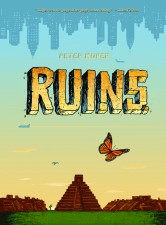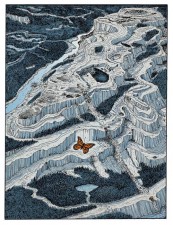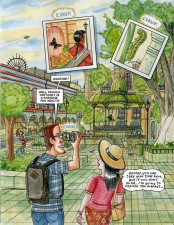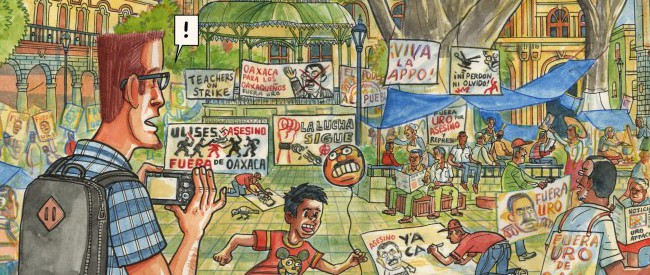A tormented couple’s personal struggles take on cosmic proportions in Ruins, a significant new work from master cartoonist Peter Kuper. With both technical proficiency and emotional accuracy, Kuper presents an immersive tale of endings and rebirths in the vibrant Mexican town of Oaxaca.
 The genre of graphic literature concerning Mexican-American cultural exchange has its share of titans. Namely, Los Bros Hernandez and Jessica Abel (especially in La Perdida, which shares several key themes with Ruins) have tackled this broad topic through their own personal history and Mexico’s grand mythology. Kuper’s new 328-page tome is a welcome addition to this field’s Great Works, and an exciting milestone in a career stretching back over 30 years.
The genre of graphic literature concerning Mexican-American cultural exchange has its share of titans. Namely, Los Bros Hernandez and Jessica Abel (especially in La Perdida, which shares several key themes with Ruins) have tackled this broad topic through their own personal history and Mexico’s grand mythology. Kuper’s new 328-page tome is a welcome addition to this field’s Great Works, and an exciting milestone in a career stretching back over 30 years.
The book opens with a tightly focused sequence of a monarch butterfly emerging from its cocoon, in the first step of a journey that’s interspersed with that of the book’s main human characters. Caustic entomologist George has agreed to join his girlfriend Samantha on her sabbatical to Oaxaca – an opportunity for her to finish the book which she still hasn’t told him any details about.
After leaving their jobs, their home, and everything else they know, George and Samantha find themselves face to face in seductive but unfamiliar new surroundings. Old wounds are reopened and new ones revealed as the two find their paths diverging in surprising ways.
Ruins draws on Kuper’s own time living in Mexico with his wife and daughter during 2006-08. The reader can choose to make his or her own assumptions about where the border between the plot’s fact and fiction lies, but there’s no denying the rich sense of detail that Kuper’s experience affords.
 Reading this work can truly be called an immersive – and at times overwhelming – experience. The Oaxaca of Ruins is so real you can almost taste it. Dogs growl, fireworks explode, cars honk—often all at the same time, represented through a combination of environmental sound effects, character expressions, and a formally inventive use of time within spreads and even individual panels. It’s not uncommon for characters to appear multiple times within a single set of borders to convey movement (in one instance, an animated landlady’s frenetic demeanor is represented by Janus-like dual faces).
Reading this work can truly be called an immersive – and at times overwhelming – experience. The Oaxaca of Ruins is so real you can almost taste it. Dogs growl, fireworks explode, cars honk—often all at the same time, represented through a combination of environmental sound effects, character expressions, and a formally inventive use of time within spreads and even individual panels. It’s not uncommon for characters to appear multiple times within a single set of borders to convey movement (in one instance, an animated landlady’s frenetic demeanor is represented by Janus-like dual faces).
Kuper’s colors also lend the setting its authentic tone. An accomplished magazine illustrator, he utilizes a similar washed-out palate to convey the city’s sun-baked feel.
At the core of Ruins is a keen dissection of the ways in which the personal, the natural, and the political intermingle. Samantha’s memories of a previous visit to the city spur her to dive deeper into her writing , which also appears as fragments throughout the book. These passages reveal Samantha’s tragic past, as seen through the lens of Mexican history and myth.
 Sam’s singlemindedness leaves George with plenty of time for exploring the city. Initially he’s none too pleased about this fact, spending his time observing the city and its insect inhabitants behind his camera lens. However, an annual teachers’ strike and a friendship with a washed-up photojournalist leaves George more deeply connected with Oaxaca and its struggles – and sets in motion a momentous series of events which leaves all involved changed forever.
Sam’s singlemindedness leaves George with plenty of time for exploring the city. Initially he’s none too pleased about this fact, spending his time observing the city and its insect inhabitants behind his camera lens. However, an annual teachers’ strike and a friendship with a washed-up photojournalist leaves George more deeply connected with Oaxaca and its struggles – and sets in motion a momentous series of events which leaves all involved changed forever.
Ruins isn’t the kind of book you can take in over the course of an afternoon. Even its wordless sequences are packed with moment, inviting the reader to stay and linger a while (even if you’d rather look away). But it’s also anything but obtuse, illuminating the realities of a disintegrating relationship in ways that will be familiar to almost anyone. Much like Oaxaca itself, Ruins is a work that’s worth getting lost in.
Peter Kuper (W/A) • SelfMadeHero, September 22















